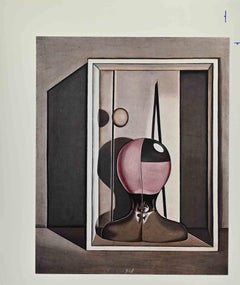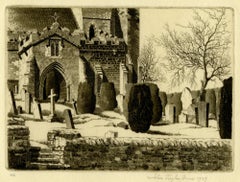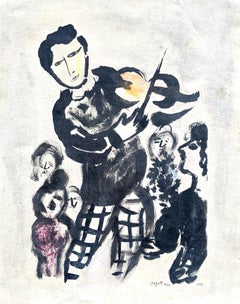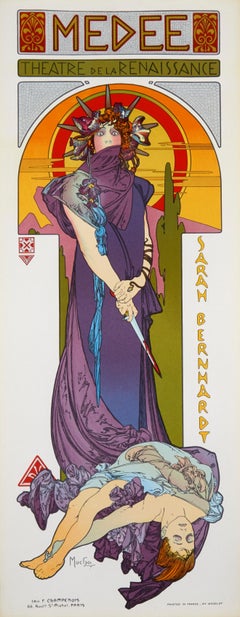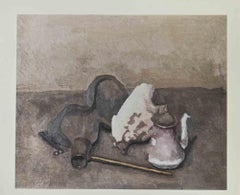20th Century Figurative Prints
to
6,068
12,658
4,403
5,388
1,945
873
Overall Width
to
Overall Height
to
8,663
4,317
2,245
1,324
893
881
554
524
397
90
55
19
18
16
830
372
326
308
297
3,537
7,599
25,342
6,830
293
597
1,415
1,242
1,342
2,279
3,257
5,156
2,831
1,318
3,033
17,370
7,469
386
16,113
9,071
7,798
5,269
5,206
4,118
3,573
2,906
1,661
1,247
1,173
1,096
912
755
693
682
669
590
574
551
11,796
6,006
2,883
2,301
2,055
2,588
9,622
13,081
9,815
Period: 20th Century
Metaphysical Still Life - Offset Print after Giorgio Morandi - Mid-20th Century
Located in Roma, IT
Metaphysical Still Life is a vintage offset print, reproducing the original watercolor of 1918 by Giorgio Morandi.
Very Good conditions.
Category
Modern 20th Century Figurative Prints
Materials
Offset
Stanwick Churchyard
Located in Middletown, NY
Etching on cream wove paper, 2 3/8 x 3/14 inches (61 x 83), full margins. Signed, dated and inscribed "IV" in the artist's hand. In very good condition. Fletcher states only two tria...
Category
American Modern 20th Century Figurative Prints
Materials
Handmade Paper, Etching, Aquatint
"Fish Dish"- Figurative Abstract Still-Life
By Morag Muir
Located in Soquel, CA
"Fish Dish" by Morag Muir (Scottish, b. 1960). Screen print on paper Signed "Morag Muir" and dated "87" lower right. Titled "Fish Dish" center and numbered "...
Category
Abstract Expressionist 20th Century Figurative Prints
Materials
Printer's Ink, Laid Paper, Screen
Chagall, Composition, Couleur amour (after)
By Marc Chagall
Located in Southampton, NY
Lithograph and stencil on vélin papier a la cuve du Moulin Richard de Bas spécialement filigrané pour cette édition paper. Signed in the plate and unnumbered, as issued. Good conditi...
Category
Modern 20th Century Figurative Prints
Materials
Lithograph, Stencil
$7,196 Sale Price
20% Off
Medee - Sarah Bernhardt (after) Alphonse Mucha, 1969
Located in New York, NY
These beautiful and colorful lithographic posters were hand reproduced by the Mourlot Studio's Master Printer Henri Deschamps in 1969. They are not to be mistaken with later cheap di...
Category
Art Nouveau 20th Century Figurative Prints
Materials
Lithograph
Still Life - Offset Print after Giorgio Morandi - 1929
Located in Roma, IT
Still life is a vintage offset print, realized in 1929 reproducing the original watercolor by Giorgio Morandi.
Very Good conditions.
Category
Modern 20th Century Figurative Prints
Materials
Offset
When Abdullah got the Net Ashore - French Art - Symbolism, Fauvism Art
By Marc Chagall
Located in London, GB
MARC CHAGALL 1887-1985
[Shagal, Mark, Zakharovich, Moses]
Vitebsk, Belarus 1887-1985 Saint-Paul-de-Vence, Alpes-Maritimes
Title: When Abdullah got the Net Ashore…, from: Four Tales...
Category
Fauvist 20th Century Figurative Prints
Materials
Lithograph
Didn't He Ramble? (Jazz Musician Trumpet Player)
Located in Wilton Manors, FL
Whitford Carter (1915-1973). Didn't He Ramble?, 1964. Lithograph on paper, image measures 13 x 17 inches; 19 x 22 inches in original frame. Signed, dat...
Category
American Realist 20th Century Figurative Prints
Materials
Lithograph
Moto-Flirt
Located in Fairlawn, OH
Moto-Flirt
Color lithograph, c. 1902
Signed in the stone lower right (see photo)
Published by Edmund Sagot (1857-1917), Paris
Printed by Atelier Chaix, Paris
Large edition with title...
Category
Art Nouveau 20th Century Figurative Prints
Materials
Lithograph
Les Laveuses, 2e Pensee (The Washerwoman)
Located in Fairlawn, OH
Les Laveuses, 2e Pensee (The Washerwomen)
Lithograph, c. 1910
Unsigned (as issued)
Edition: c.30-50 impressions
Condition: Rust spot, associated with pape...
Category
Impressionist 20th Century Figurative Prints
Materials
Lithograph
Braque, Sans titre, Verve: Revue Artistique et Littéraire (after)
Located in Southampton, NY
Lithograph on vélin du Marais paper. Inscription: Unsigned and unnumbered, as issued. Good condition. Notes: From the volume, The Intimate Sketchbooks of G. Braque, Verve: Revue Arti...
Category
Modern 20th Century Figurative Prints
Materials
Lithograph
$716 Sale Price
20% Off
MUNECA
Located in Aventura, FL
Limited edition linocut on paper. Hand signed and numbered lower front Angel Botello. From the edition of 60. Frame size approx 29.75 x 26.5 inches (frame molding may have some m...
Category
Contemporary 20th Century Figurative Prints
Materials
Linocut
$5,962 Sale Price
25% Off
Picasso, Composition, Les Métamorphoses (after)
Located in Fairfield, CT
Medium: Lithograph on vélin papier Vergé fin blanc des papeteries de Bellerive paper
Year: 1970
Paper Size: 11.024 x 8.66 inches
Inscription: Inscription: Unsigned and unnumbered, as...
Category
Cubist 20th Century Figurative Prints
Materials
Lithograph
$716 Sale Price
20% Off
René Magritte - LA DURÉE POIGNARDÉE Limited Surrealism French Contemporary
Located in Madrid, Madrid
René Magritte - LA DURÉE POIGNARDÉE, 1938 (TIME TRANSFIXED)
Date of creation: 2010
Medium: Lithograph on BFK Rives Paper
Edition: 275
Size: 60 x 45 cm
Condition: In very good conditi...
Category
Surrealist 20th Century Figurative Prints
Materials
Paper, Lithograph
Bob Hope Hollywood Legend 20th Century Oscars Academy Awards Litho Movie Star
Located in New York, NY
Bob Hope Hollywood Legend 20th Century Oscars Academy Awards Litho Movie Star
Al Hirschfeld (1903-2003)
Bob Hope
Signed lower right, Numbered 16/200 lower left
15 x 11 3/4 inches (...
Category
Performance 20th Century Figurative Prints
Materials
Lithograph
Standing Dancer, Leaning from: Ten Dancers - Lithograph - French - Fauvism Art
Located in London, GB
HENRI MATISSE 1869-1954
(Emile Benoît)
Le Cateau-Cambrésis 1869-1954 Nice (French)
Title: Standing Dancer, Leaning, from: Ten Dancers Danseuse debout, accoudée, Dix Danseuses, 1925...
Category
Post-Impressionist 20th Century Figurative Prints
Materials
Lithograph
"Yvette Guilbert" by Toulouse-Lautrec
Located in Hinsdale, IL
TOULOUSE-LAUTREC, HENRI DE
(1864-1901)
"Yvette Guilbert – A Menilmontant de Bruant"
Delteil 255, Adhemar 311
Lithograph printed in black with beige t...
Category
Art Nouveau 20th Century Figurative Prints
Materials
Lithograph
Star Wars Darth Vader The Empire Strikes Back 1980 Vintage Cinema Card
Located in London, GB
Star Wars: The Empire Strikes Back 1980 Vintage Lobby Card #10
Original Star Wars lobby card of Darth Vader walking through Hoth base
Framing options available: Black, brown, whit...
Category
Modern 20th Century Figurative Prints
Materials
Paper, Cardboard
Praying in The Snow - Lithograph After Utagawa Hiroshige - Mid 20th Century
Located in Roma, IT
Praying in The Snow is a modern print realized in the Mid-20th Century.
Mixed colored lithograph after a woodcut realized by the great Japanese ar...
Category
Modern 20th Century Figurative Prints
Materials
Lithograph
'Search' — Australian Romanticism
Located in Myrtle Beach, SC
Thomas Balfour Garrett, 'Search', monotype in colors, c. 1910, a unique impression. Signed and titled in pencil. A superb, painterly impression with fresh colors on off-white, wove p...
Category
Romantic 20th Century Figurative Prints
Materials
Monotype
Landscape by Moonlight, Barges in Vietnam lithograph by Vietnamese Master
Located in Norwich, GB
Wonderful original original artist's proof lithograph by Vietnamese/French Master Dang Lebadang. Marked EA (for "Epreuve d'Artiste" lower left, signed lo...
Category
Abstract Impressionist 20th Century Figurative Prints
Materials
Lithograph
Magritte, Composition, Poèmes 1923-1958, Dix dessins de René Magritte (after)
Located in Southampton, NY
Lithograph on vélin du Marais paper. Paper Size: 11 x 8.25 inches. Inscription: Signed in the plate and unnumbered, as issued. Notes: From the volume, Poèmes 1923-1958. Dix dessins d...
Category
Surrealist 20th Century Figurative Prints
Materials
Lithograph
$716 Sale Price
20% Off
FROM BEDROOM PAINTING #41
Located in Aventura, FL
Screenprint on museum board. Hand signed and numbered by the artist. Edition of 100. Published by International Images, Putney, Vermont. Sheet size 59 x 68 inches. Artwork is in e...
Category
Pop Art 20th Century Figurative Prints
Materials
Board, Screen
Andy Warhol Studies for a Boy Book (1950s Warhol illustrated announcement)
By Andy Warhol
Located in NEW YORK, NY
Andy Warhol Studies for a Boy Book 1956:
A rare sought-after, 1950s Andy Warhol designed poster invitation published on the occasion of: Warhol's 'Studies for a Boy Book', held at the Bodley Gallery and Bookshop Feb. 14 - March 3, 1956. A rare early Warhol collectible that seldom comes to market. Not to be passed upon.
Medium: Offset lithograph on wove paper. Framed in glass.
Dimensions: 15.75 x 13.5 inches (40 x 34.3 cm).
Framed dimensions: 24h x 26w inches.
Good overall vintage condition; fold-lines as originally issued;
Unsigned from an edition of unknown. Rare.
With the Estate of Andy Warhol and the Andy Warhol Foundation for the Visual Arts Authorization ink-stamps on the reverse; initialed 'T.J.H.' by Timothy J. Hunt of the Andy Warhol Foundation and annotated 'XX-07.16' and 'PM19.0242' in pencil on the reverse.
Provenance:
The Andy Warhol Foundation for the Visual Arts, New York
Susan Sheehan Gallery, New York
Private Collection, New York
Further Background:
"In the 1950's Warhol self-published a large series of artist’s books & hold parties at Serendipity 3, a restaurant and ice cream parlor on Manhattan’s Upper East Side, where his friends would help him hand color his books. In 1956, he presented a solo exhibition at the Bodley Gallery called Studies for a Boy Book. These sketchbook drawings of portraits of young men and erotic portrayals of male nudes contrasted with the work of other contemporary gay artists, such as Robert Rauschenberg and Jasper Johns, who considered Warhol 'too swish.' (source: The Andy Warhol Museum)
Collections:
The Art Institute of Chicago
Further background:
Warhol’s career began as a commercial illustrator on New York’s Madison Avenue in 1949, during the massive post-war economic boom. His arrival additionally coincided with an extensive change in the motivations and strategies behind advertising, utilizing applied psychology to influence American consumers to purchase products. This stint as an ad man would further his Pop interest in cultural commercialization and start his artistic career; thus began the first chapter of Warhol’s oeuvre, dominated by charming and light-handed ink drawings.
As a master of line and contour, Warhol’s consistent and unique drawings and designs piqued the interest of his clients, earning him commissions and collaborations with some of the biggest brands of the day: Tiffany & Co., Columbia Records, and Vogue, to name a few. Though stylistically different from the Pop, these early drawings offer a glimpse at an artist well on his way to establishing an art movement that would change the way the world conceived of contemporary art and its connection to pop culture, morphing from his early successes in the commercial art scene.
The simple yet sophisticated line drawings contain... his favorite things: cherubs, shoes, cats, and often young men. Across these drawings and hand-colored prints, we see Warhol as a compulsive creator, documenting life and fantasy with the stark clarity of ink on paper." (source: Phillips)
_
Obsessed with celebrity, consumer culture, and mechanical reproduction, Pop Art king, Andy Warhol created some of the 20th century’s most iconic images. Warhol was widely influenced by popular & consumer culture, with this being evident in some of his most famous works: 32 Campbell's soup cans, Brillo pad box sculptures, and portraits of Marilyn Monroe & Mick Jagger, for example. Rejecting the standard painting and sculpting modes of his era, Warhol embraced silk-screen printmaking to achieve his characteristic hard edges and flat areas of color. The artist mentored Keith Haring and Jean-Michel Basquiat and continues to influence contemporary art around the world: His most bold successors include Richard Prince, Takashi Murakami, and Jeff Koons. Warhol has been the subject of exhibitions at the Whitney Museum of American Art, Museum of Modern Art, Tate Modern, and Centre Pompidou, among other institutions.
Related Categories
1950s Andy Warhol. Vintage Andy Warhol. Mid century modern. Pop Art. Andy Warhol advertising...
Category
Pop Art 20th Century Figurative Prints
Materials
Paper, Lithograph
Art Deco 1925, Pop Art Screenprint by Michael Knigin
Located in Long Island City, NY
Michael Knigin, American (1942 - 2011) - Art Deco 1925, Year: 1980, Medium: Screenprint, signed. numbered, dated, and titled in pencil, Edition: AP, Image Size: 30 x 17 inches, S...
Category
Pop Art 20th Century Figurative Prints
Materials
Screen
Nude Woman and Servant - Original Lithograph (Mourlot)
Located in Paris, IDF
Pablo PICASSO (1881-1973),
Nude Woman and Servant, 1954
Original lithography (Mourlot workshop)
Unsigned
Printed date in the plate
On paper 26 .5 x 35.5 cm (c. 10,2 x 13.7 in)
INF...
Category
Modern 20th Century Figurative Prints
Materials
Lithograph
Original "The City of New Orleans" Amtrak vintage travel poster
Located in Spokane, WA
Original “The City of New Orleans” Amtrack railroad travel poster. The only thing that separates Chicago from New Orleans is your imagination. Archival linen backed in excellent, ...
Category
Abstract 20th Century Figurative Prints
Materials
Offset
CALYPSO Signed Lithograph Man Playing Clarinet, Pin Stripe Suit, Yellow Hot Pink
By Robin Morris
Located in Union City, NJ
CALYPSO by the woman artist Robin Morris, is an original limited edition lithograph printed using hand lithography techniques(not a photo reproduction or digital print) on archival Arches paper, 100% acid free. CALYPSO is a contemporary musical portrait portraying a man playing clarinet dressed in a yellow pin stripe suit...
Category
Art Deco 20th Century Figurative Prints
Materials
Lithograph
Lovers With Red Sun
By Marc Chagall
Located in Washington, DC
Artist: Marc Chagall
Title: Lovers With Red Sun
Portfolio: Mourlot Lithographe I
Medium: Lithograph
Year: 1960
Edition: Unnumbered
Framed Size: 20 1/2" x 17 1/2"
Image Size: 9 1/2" x...
Category
20th Century Figurative Prints
Materials
Lithograph
'Dark Vessel' — Mid-Century Modern
Located in Myrtle Beach, SC
Edward Landon, 'Dark Vessel', color serigraph, 1952, edition 50, Ryan 51. Signed, dated, and titled in pencil. A superb impression, with fresh colors, on c...
Category
American Modern 20th Century Figurative Prints
Materials
Screen
$600 Sale Price
20% Off
Matisse, Série L, var. 13 (Duthuit 9), Dessins, Thèmes et variations (after)
Located in Southampton, NY
Lithograph on vélin pur fil paper. Inscription: Signed in the plate and unnumbered, as issued. Good condition. Notes: From the folio, Henri Matisse, Dessins, Thèmes et Variations, 19...
Category
Modern 20th Century Figurative Prints
Materials
Lithograph
$796 Sale Price
20% Off
Lithographie VI (Duthuit 20), Repli, Gravures de Henri Matisse
Located in Southampton, NY
Lithograph on vélin a la forme des papeteries d'Arches paper. Unsigned and unnumbered, as issued. Good condition. Notes: From the volume, Repli, Gravures de Henri Matisse, 1947. Publ...
Category
Modern 20th Century Figurative Prints
Materials
Lithograph
$5,196 Sale Price
20% Off
Woman with a Rose - Stone lithograph - Mourlot 1965
By Jean Carzou
Located in Paris, IDF
Jean CARZOU
Woman with a Rose
Stone lithograph in colors (printed in Atelier Mourlot)
Printed signature in the plate
On Arches vellum 38 x 28 cm (c. 15 x 11 in)
INFORMATION :
Edit...
Category
Modern 20th Century Figurative Prints
Materials
Lithograph
Candiques - Héliogravure by Marc Chagall - 1960
By Marc Chagall
Located in Roma, IT
Héliogravure on brown-toned paper, so signature.
Héliogravure on bot sheets, recto and verso.
Edition of 6500 unsigned copies. Printed by Mourlot and published by Tériade, Paris.
...
Category
Surrealist 20th Century Figurative Prints
Materials
Photogravure
Composition, Le Livre Blanc, Jean Cocteau
By Jean Cocteau
Located in Southampton, NY
Lithograph and stencil with hand coloring on vélin d'Arches paper. Inscription: unsigned and unnumbered, as issued. Good condition. Notes: from the folio, Le Livre blanc, précédé d'u...
Category
Modern 20th Century Figurative Prints
Materials
Lithograph, Stencil
$3,036 Sale Price
20% Off
Miró, Composition, Derrière le miroir (after)
By Joan Miró
Located in Southampton, NY
Lithograph on vélin paper. Inscription: Unsigned and unnumbered, as issued. Good condition, with bifold, as issued. Notes: From volume, Derrière le miroir, N° 125-126, 1961. Publishe...
Category
Surrealist 20th Century Figurative Prints
Materials
Lithograph
$1,996 Sale Price
20% Off
Composition, Vers un monde volage, Marcel Gromaire
Located in Southampton, NY
Etching on vélin d'Arches paper. Unsigned and unnumbered, as issued. Good condition. Published by Éditions Marcel Seheur, Paris; printed by Atelier d'art Paul Haasen, Paris, Septembe...
Category
Modern 20th Century Figurative Prints
Materials
Etching
$1,436 Sale Price
20% Off
"Daikoku, Dieu de la Richesse" Japanese Style Woodblock Print
Located in Austin, TX
A woodblock print of a Japanese geisha in elegant clothing against a yellow decorative background.
By Paul Jacoulet
15.5" x 12" Woodblock print on paper
Framed Size: 22.5" x 18.5"
...
Category
20th Century Figurative Prints
Materials
Paper, Woodcut
The Rabbit - Original Woodcut by Giselle Hallf - Early 20th Century
Located in Roma, IT
The Rabbit is an original woodcut print by Giselle Hallf in the first half of the 20th Century.
Good conditions.
The artwork is depicted through strong strokes in a well-balanced c...
Category
Modern 20th Century Figurative Prints
Materials
Woodcut
La Maison dans les arbres, Regards sur Paris, Jean Carzou
By Jean Carzou
Located in Southampton, NY
Lithograph on vélin d’Arches paper. Inscription: unsigned and unnumbered, as issued. Good condition. Notes: from the folio, Regards sur Paris, 1963. Published by André Sauret, Paris;...
Category
Modern 20th Century Figurative Prints
Materials
Lithograph
$876 Sale Price
20% Off
Toulouse-Lautrec, Composition, Henri de Toulouse-Lautrec, Dessinateur (after)
Located in Southampton, NY
Lithograph on vélin paper. Paper size: 12.25 x 9.25 inches. Inscription: Signed in the plate and unnumbered, as issued. Notes: From the album, Henri de Toulouse-Lautrec, Dessinateur,...
Category
Post-Impressionist 20th Century Figurative Prints
Materials
Lithograph
$716 Sale Price
20% Off
"Paris and Helen of Troy" signed etching by Salvador Dali. Edition 430 of 1000.
Located in Boca Raton, FL
"Paris and Helen of Troy" framed etching by Salvador Dali printed on Arches paper. Hand-numbered 430/1000 on lower left front corner. Hand-signed o...
Category
Surrealist 20th Century Figurative Prints
Materials
Etching
Salvador Dali - Nude with Snail
Located in Collonge Bellerive, Geneve, CH
Salvador Dali - Nude with Snail - Original Etching
Dimensions: 38 x 28 cm
Edition: 235
1967
embossed signature
On Arches Vellum
References : Field 67-10 (p. 34-35)
Category
Surrealist 20th Century Figurative Prints
Materials
Etching
3 Biennale Internationale de L'estampe, France 1968 Miss American Indiana poster
Located in New York, NY
Richard Lindner
3 Biennale Internationale de L'estampe (International Biennale of Graphic Arts), Miss American Indian, 1968
Silkscreen on wove paper
Unnumbered
35 1/2 × 23 1/2 inches...
Category
Pop Art 20th Century Figurative Prints
Materials
Screen
Picasso, Composition (Cramer 84), Picasso en marge du Buffon (after)
Located in Fairfield, CT
Medium: Lithograph on vélin du Marais paper
Year: 1957
Paper Size: 14.5 x 11 inches
Catalogue raisonné reference: Cramer, illustration 84
Inscription: Inscription: Unsigned and unnum...
Category
Cubist 20th Century Figurative Prints
Materials
Lithograph
$956 Sale Price
20% Off
Composition (Mourlot 668-677), La Féerie et Le Royaume, Marc Chagall
By Marc Chagall
Located in Southampton, NY
Lithograph on vélin d’Arches paper. Unsigned and unnumbered, as issued. Good condition. Notes: From the folio, La Féerie et Le Royaume, Lithographies Originales de Marc Chagall, 1972...
Category
Modern 20th Century Figurative Prints
Materials
Lithograph
$4,796 Sale Price
20% Off
"Charge of the Revolutionist Cavalry" - 1931 Woodcut On Paper
Located in Soquel, CA
"Charge of the Revolutionist Cavalry" - 1931 Woodcut On Paper
1931 Black and white woodcut print titled "Charge of the Revolutionist Cavalry" by Leo...
Category
Contemporary 20th Century Figurative Prints
Materials
India Ink, Laid Paper, Woodcut
"UNTITLED" FROM POP SHOP V
By Keith Haring
Located in Aventura, FL
Screenprint in colors, on wove paper. Stamped with the artist's estate and signed, dated and numbered by the executor, Julia Gruen, in pencil on the rever...
Category
Pop Art 20th Century Figurative Prints
Materials
Screen, Paper
James McBey
Located in Storrs, CT
Fletcher 6 state .ix. 10 1/2 x 7 1/2 (sheet 14 7/8 x 11 3/8). Edition 111. A rich impression printed on cream wove paper with full margins. Excellent condition. Illustrated: Fine ...
Category
Modern 20th Century Figurative Prints
Materials
Drypoint, Etching
$1,775 Sale Price
29% Off
Ubac, Composition, Derrière le miroir (after)
By Raoul Ubac
Located in Southampton, NY
Lithograph on vélin paper. Inscription: Unsigned and unnumbered, as issued. Good condition. Notes: From Derrière le miroir, N° 105-106, 1958. Published by Aimé Maeght, Éditeur, Paris...
Category
Modern 20th Century Figurative Prints
Materials
Lithograph
$716 Sale Price
20% Off
Les Amoureux - Lithograph after Fernand Léger - 1959
Located in Roma, IT
Lithograph realized after Fernand Léger in 1959, on Moulin Richard de Bas paper.
Monogrammed in the plate.
It belongs to the suite "Contrastes", printed by Daniel Jacomet and publi...
Category
Cubist 20th Century Figurative Prints
Materials
Lithograph
Vintage Bob Dylan Souvenir Poster (Milton Glaser Bob Dylan 1960s)
Located in NEW YORK, NY
Original 1967 Milton Glaser Fold Out Poster for Bob Dylan's Greatest Hits.
Offset lithograph printed in colors 33 x 22 in (83.82 x 55.88 cm)
Fold lines as issued; very good vinta...
Category
Pop Art 20th Century Figurative Prints
Materials
Lithograph
$227 Sale Price
30% Off
STEHENDE KNABE UND ZWEI MADCHEN
By Otto Mueller
Located in Portland, ME
Mueller, Otto. STEHENDE KNABE UND ZWEI MADCHEN. Karsch 67. Lithograph, 1917. 12 3/4 x 9 7/8 inches; 323 x 250 mm. Monogrammed in the stone. Edition of about 300. In excellent conditi...
Category
20th Century Figurative Prints
Materials
Lithograph
Jérémie (Mourlot 117-46; Cramer 25)
By Marc Chagall
Located in Southampton, NY
Lithograph on vélin des Papeteries du Marais paper. Paper Size: 14 x 10.25 inches. Inscription: Unsigned and unnumbered, as issued. Catalogue raisonné references: Cain, Julien, and F...
Category
Expressionist 20th Century Figurative Prints
Materials
Lithograph
$956 Sale Price
20% Off
Deux Femmes en une, Surrealist Etching by André Masson
By André Masson
Located in Long Island City, NY
André Masson, French (1896 -1987) - Deux Femmes en une, Year: 1956, Medium: Etching, Image Size: 9.75 x 8 inches, Size: 11 x 9.75 in. (27.94 x 24.77 cm), Description: From the c...
Category
Surrealist 20th Century Figurative Prints
Materials
Etching
Matisse, Crayon, Dessins de Henri-Matisse (after)
Located in Southampton, NY
Lithograph on vélin Lafuma paper. Unsigned and unnumbered, as issued. Good Condition; never framed or matted. Notes: From the volume, Dessins de Henri-Matisse, 1925. Published by Édi...
Category
Modern 20th Century Figurative Prints
Materials
Lithograph
$956 Sale Price
20% Off
PEGASUS, Woodcut, Limited Edition, signed by the Artist
Located in Palm Desert, CA
"PEGASUS" (1976) by Norbert Matzdorf
Woodcut print on paper
Limited Edition, numbered (8.3), dated and hand-signed by the artist
27,9 x 38,3 cm
Norbert Matzdorf (1951 – 2013) After ...
Category
20th Century Figurative Prints
Materials
Paper
YASHIVA IN JERUSALEM (JUDAICA ART)
By Amram Ebgi
Located in Aventura, FL
Embossed lithograph with foil stamping on paper. Hand signed and numbered by the artist. From the edition of 300.
Artwork is in excellent condition. Certificate of authenticity in...
Category
Contemporary 20th Century Figurative Prints
Materials
Foil
$100 Sale Price
50% Off
The Chair - Lithograph by Raoul Dufy - 1920
By Raoul Dufy
Located in Roma, IT
The Chairis a vintage lithograph realized after Raoul Dufy in 1920.
Good conditions.
Edition of 110. Not signed and not numbered, as issued.
The artwork is depicted through confid...
Category
Modern 20th Century Figurative Prints
Materials
Lithograph
France at her Furnaces
By James McBey
Located in Storrs, CT
1917. Etching. Hardie 175. 8 x 15 (sheet 10 1/8 x 16 15/16). Edition 76. Slight mat line; otherwise excellent condition. A rich impression printed on antique laid paper with full m...
Category
Modern 20th Century Figurative Prints
Materials
Drypoint, Etching
Recently Viewed
View AllMore Ways To Browse
Kim Tschang Yeul
Tom Blackwell On Sale
Tom Everhart Lithograph
Torii Kotondo
Victor Richardson
Vintage Boulangerie Signs
Vintage Les Nereides
Vintage Meat Scales
Vintage Multiplier Reel
Warhol Northwest Mask
Whistler Fumette
Yoko Ono Lithograph Harold Town
Zeno Giglietti
Ak47 Lotus
Alex Katz Bicycle
Alex Katz Christy
Alex Katz Twilight
Alex Katz Wedding Dress
